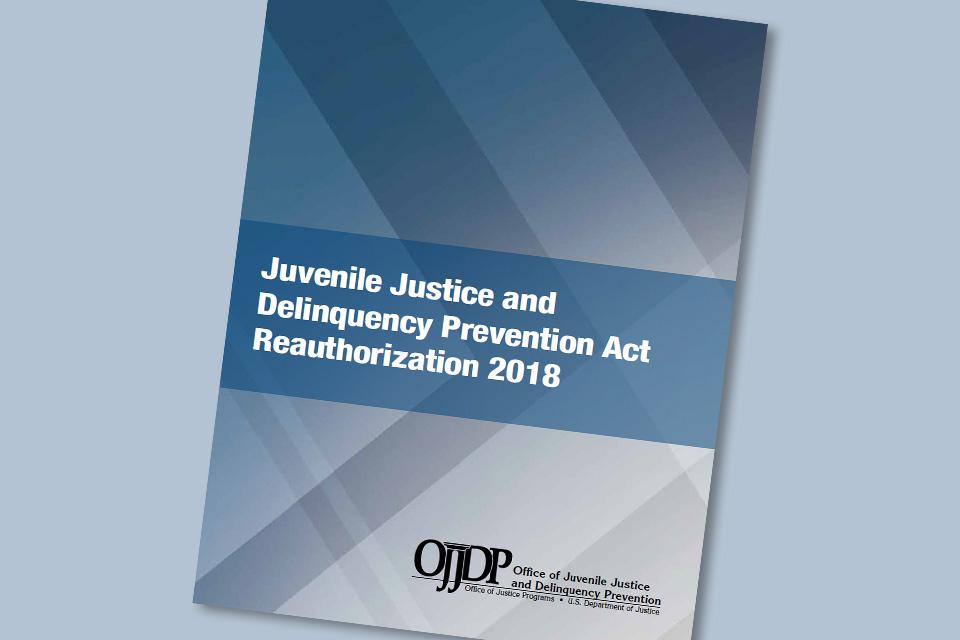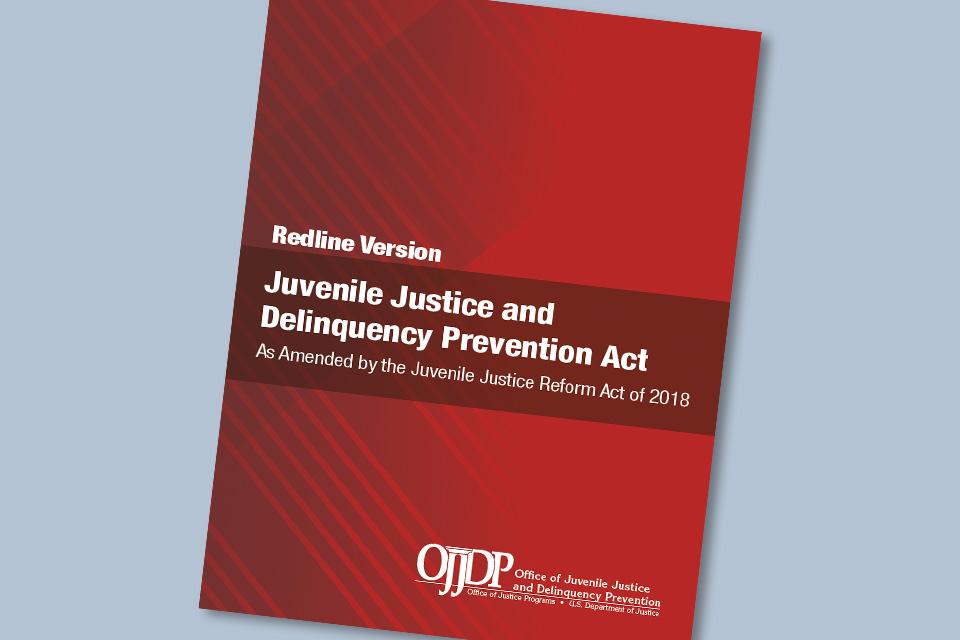In December 2018, the Juvenile Justice Reform Act of 2018 was signed into law, reauthorizing and substantially amending the Juvenile Justice and Delinquency Prevention (JJDP) Act of 1974 (JJDP Act). OJJDP will work with states to implement the new requirements. The information on this page assists states in monitoring and achieving compliance with the core requirements specified in the JJDP Act.
Announcements:
- OJJDP Fact Sheet: Key Amendments to the Juvenile Justice and Delinquency Prevention Act Made by the Juvenile Justice Reform Act of 2018.
- Compliance Monitoring Online Reporting Tool
Juvenile Justice and Delinquency Prevention Act
- 2018 Reauthorization
- Juvenile Justice Reform Act of 2018 (JJRA)
- Juvenile Justice and Delinquency Prevention (JJDP) Act of 1974 (as Amended Through P.L. 115-385, enacted December 21, 2018)
- OJJDP Fact Sheet: Key Amendments to the Juvenile Justice and Delinquency Prevention Act Made by the Juvenile Justice Reform Act of 2018.
- Redlined version of the JJDP Act with 2018 JJRA amendments.
- 2002 Reauthorization
- JJDP Act History through 1992
The following is OJJDP's existing regulation implementing the Juvenile Justice and Delinquency Prevention Act of 1974, as amended. Please be advised, however, that OJJDP is currently drafting a revised regulation to reflect amendments made to the Juvenile Justice and Delinquency Prevention Act in legislation enacted in 2002 (Public Law No. 93-415) and 2018 (Public Law No. 115-385).
Federal Register Notices:
- Federal Register, August 8, 2016, Notice of Proposed Rulemaking
- Federal Register, January 17, 2017, Juvenile Justice and Delinquency Prevention Act Formula Grant Program - A Rule
- Federal Register, February 1, 2017, Juvenile Justice and Delinquency Prevention Act Formula Grant Program - A Rule (Final rule; delay of effective date.)
- Access summary charts of State Compliance With JJDP Act Core Requirements for Fiscal Years 2006 - 2022.
- Access summary chart of State use of the Valid Court Order Exception (VCO) for Fiscal Year 2016
- Compliance Determination Standards
- FY 2024 Compliance Determination Standards
- FY 2023 Compliance Determination Standards
- FY 2022 Compliance Determination Standards
- FY 2021 Compliance Determination Standards
- FY 2020 Compliance Determination Standards
- FY 2019 Compliance Determination Standards
- FY 2018 Compliance Determination Standards
- FY 2017 Compliance Determination Standards
- FY 2016 Compliance Determination Standards
"To receive an award under the Title II, Part B, Formula Grants program (as authorized at 34 U.S.C. §§ 11131-11133 the Juvenile Justice and Delinquency Prevention (JJDP) Act) states must, each year, satisfy 33 state plan requirements. If a state does not meet these requirements, it is not eligible to receive its Formula Grants program allocation for that year.
Within these 33 requirements, 4 are deemed to be "core" because by statute OJJDP must reduce a state's annual formula grant award by 20 percent for each requirement with which the state is out of compliance.
The core requirements are:
- Deinstitutionalization of status offenders (DSO): 34 U.S.C. 11133 (a) (11);
- Separation of juveniles from adult inmates (separation): 34 U.S.C. 11133 (a) (12);
- Removal of juveniles from adult jails and lockups (jail removal): 34 U.S.C. 11133 (a) (13); and
- Addressing racial and ethnic disparities: 34 U.S.C. 11133 (a) (15).
Implementing the core requirements is essential to states creating a fair, consistent, and effective justice system that advances the goals of the Formula Grants program. Pursuant to the Formula Grants program, participating states must submit an annual compliance report that includes data to demonstrate they have maintained or achieved compliance with the DSO, separation, and jail removal requirements. States must also submit an annual Racial and Ethnic Disparities core requirement plan that describes how the state will address racial and ethnic disparities.
Another of the 33 plan requirements is that states must provide for an effective compliance monitoring system. Pursuant to 34 U.S.C. § 11133 (a)(14), participating states shall:
Provide for an effective system of monitoring jails, lock-ups, detention facilities, and correctional facilities to ensure that the core requirements are met, and for annual reporting of the results of such monitoring to the Administrator, except that such reporting requirements shall not apply in the case of a State which is in compliance with the other requirements of this paragraph, which is in compliance with the requirements in paragraphs (11) and (12), and which has enacted legislation which conforms to such requirements and which contains sufficient enforcement mechanisms to ensure that such legislation will be administered effectively;
To verify the effectiveness of a state's compliance monitoring system under the JJRA, OJJDP will conduct periodic compliance monitoring field audits that assess implementation of the following required elements:
- Policies and Procedures
- Monitoring Authority
- Violation Procedures
- Adherence to Federal Definitions
- Identification of the Monitoring Universe
- Classification of the Monitoring Universe
- Inspection of Facilities
- Data Collection, Verification, and Analysis
FY 2024 Reporting Requirements
FY 2023 Reporting Requirements
FY 2022 Reporting Requirements
FY 2021 Reporting Requirements
FY 2020 Reporting Requirements
Category 1: Due February 14, 2020. Each state should submit the following via GMS:
- Year 3 Eligibility Assurances and Certifications form.
- Plan for Compliance Monitoring describing an effective system of monitoring, as required under 34 U.S.C. § 11133(a)(14) and detailed here.
Note: An updated copy of the state’s comprehensive Compliance Monitoring Policies and Procedures Manual suffices to meet this requirement where all eight required elements are fully addressed.
- Compliance Monitoring Universe.
- Compliance Plans and Resources Certification, where applicable.
Note: Where a state was found, for the FY 2018 reporting period, to be noncompliant with the Deinstitutionalization of Status Offenders (DSO), Separation, and/or Jail Removal core requirements, the state must submit a narrative plan to achieve compliance with the noncompliant requirement(s), as detailed here.
- State Advisory Group (SAG) roster.
- Budget – GMS requires a “budget document” to be included for application submission. This document does not have to be the proposed FY 2020 budget. The document you attach can be a preliminary/estimated FY 2020 budget, or submit your FY 2019 budget document as a “placeholder.”
Note: Applicants must register in GMS for Category 1 no later than 8 p.m. ET on February 5, 2020. Any state/territory failing to meet Category 1 eligibility requirements will be notified, in writing, of this ineligibility by no later than March 20, 2020. Refer to the “How to Apply” section for details on GMS registration. In FY 2020, states will use the same GMS application for both Category 1 and Category 2. After OJJDP’s review of the state’s Category 1 materials is complete, the application will be “change requested” back to the state in GMS; the state will add the attachments due in GMS for Category 2 and resubmit that same application back for the Category 2 deadline.
Category 2: Due March 30, 2020. Each state should submit the following:
- Via the online OJJDP Compliance Reporting Tool for the period October 1, 2018, to September 30, 2019.
- State compliance data for the DSO, Separation, and Jail Removal core requirements of the JJDP Act (34 U.S.C. §§ 11133(a)(11), (12), and (13)) and supporting documentation.
- Training Policy Certification.
- Compliance Monitoring Data Certification.
- Rural Removal Exception Certification, if applicable.
- Racial and Ethnic Disparities (RED) core requirement plan, data, and supporting documentation.
- Via GMS:
- Project Abstract.
- Addendum to the 3-Year State Plan, required for all states and territories, with new information required per the JJRA.
- Any updates to the previously approved 3-Year State Plan with related narrative, or a statement indicating there are no changes to that State Plan other than the required Addendum.
- The FY 2020 budget.
- State agency contact information.
- Disclosure of Lobbying Activities Form.
- Financial Management Questionnaire.
- Disclosure of pending applications.
- Request for waiver of pass-through requirement, if applicable.
- Research and evaluation information, if applicable.
All required forms and sample documents can be located here.
FY 2019 Solicitation Requirements
- FY 2019 reporting should be completed in the Compliance Monitoring Online Reporting Tool
- For Disproportionate Minority Contact (DMC):
- For Deinstitutionalization of Status Offenders (DSO), Jail Removal and Separation:
- Annual Compliance Monitoring Report.
- Access the FY 2018 Compliance Reporting Tool spreadsheet. This new questionnaire, integrates the Office's most recent detain/confine guidance. Completed spreadsheets should be uploaded to OJJDP's online Compliance Monitoring Tool (CMT).
- Annual Compliance Monitoring Report.
- Annual Deadlines:
- Plans for Compliance with DSO, Separation and Jail Removal (OR the state's signed Certification of Adequate Plans and Resources to Maintain Compliance)
- Plan for Compliance Monitoring
- Compliance Data Report and associated attachments
- DMC Plan
Historical Reporting Tools
Access the FY 2018 Compliance Reporting Tool spreadsheet. This questionnaire, integrates the Office's most recent detain/confine guidance. Completed spreadsheets were uploaded to OJJDP's online Compliance Monitoring Tool (CMT).
FY 2016 and FY 2017 reporting years, states provided annual compliance data via OJJDP's historical Excel compliance questionnaire, available in Excel 2010 and Excel 2003 formats.
- Revised Guidance on Jail Removal and Separation Core Requirements
For questions regarding STRAD compliance site visits or guidance on DMC concerns, contact your State Representative.
States can contact their OJJDP State Program Manager.



